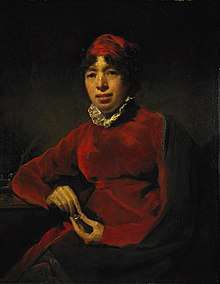Elizabeth Hamilton (writer)
Elizabeth Hamilton (1756 or 1758 – 23 July 1816)[1] was a Scottish essayist, poet, satirist and novelist.
Elizabeth Hamilton | |
|---|---|
 Portrait of Elizabeth Hamilton, 1812, by Sir Henry Raeburn. | |
| Born | 25 July 1756 Belfast, Ireland |
| Died | 23 July 1816 (aged 59) Harrogate, England |
| Occupation | Essayist, poet, novelist |
| Language | English |
Early life
She was most probably born on 25 July 1756,[2] though the date is often given as 1758.[3] She was born in Belfast, the third and youngest child of husband, Charles Hamilton (d.1759), a Scottish merchant, and his wife Katherine Mackay (d.1767). In 1762, after the death of her father, her mother sent her to live with her paternal aunt, Mrs Marshall who lived near Stirling.[4] In 1772, she lived at Ingram's Crook near Bannockburn.
Career
Her first literary efforts were directed in supporting her brother Charles in his orientalist and linguistic studies. After his death in 1792 she continued to publish orientalist scholarship, as well as historical, educationalist and theoretical works. She wrote The Cottagers of Glenburnie (1808), a tale which had much popularity in its day, and perhaps had some effect in the improvement of certain aspects of humble domestic life in Scotland. She also wrote the anti-Jacobin novel Memoirs of Modern Philosophers (1800),[5] and the satirical Translation of the Letters of a Hindoo Rajah in 1796, a work in the tradition of Montesquieu and Goldsmith.[6] Her most important pedagogical works are Letters on Education (1801), Letters on the Elementary Principles of Education (1801), Letters addressed to the Daughter of a Nobleman, on the Formation of Religious and Moral Principle (1806), and Hints addressed to the Patrons and Directors of Schools (1815).
Hamilton spent much of her later life in Edinburgh. She died in Harrogate, England after a short illness.[7]
Works
- Translation of the Letters of a Hindoo Rajah (1796).[8]
- Memoirs of Modern Philosophers (1800).
- Letters on Education (1801).
- Letters on the Elementary Principles of Education (1801).
- Memoirs of the Life of Agrippina, the wife of Germanicus (1804).
- Letters addressed to the Daughter of a Nobleman (1806).
- The Cottagers of Glenburnie (1808).
- Exercises in Religious Knowledge (1809).[9]
- A Series of Popular Essays (1813).
- Hints Addressed to the Patrons and Directors of Schools (1815).
References
- Perkins, Pam (2004). "Hamilton, Elizabeth (1756?–1816), novelist and essayist". Oxford Dictionary of National Biography. Oxford University press. Retrieved 20 December 2011.
- "Benger initially states 1758 but then excerpts Hamilton's journal entry written to celebrate her birthday in July 1815 in which Hamilton writes that 'in only one year more [...] the period of six tens of years will be completed' (Memoirs, 1: 272) – which would make 1756 her birth year." – Grogan, Claire (2013). Politics and Genre in the Works of Elizabeth Hamilton, 1756–1816. Surrey: Ashgate Publishing, p. 10.
- . Dictionary of National Biography. London: Smith, Elder & Co. 1885–1900.
- Perkins (2004).
- Ty, Eleanor (1991). "Female Philosophy Refunctioned: Elizabeth Hamilton's Parodic Novel," Archived 21 August 2016 at the Wayback Machine Ariel, Vol. 22, pp. 111–129.
- Grenby, Matthew (2001). The Anti-Jacobin Novel. Cambridge: Cambridge University Press.
- Perkins (2004).
- Ed. Pamela Perkins and Shannon Russell (1999). Broadview Press.
- Grogan (2013), p. 11.
Bibliography
![]()
Further reading
- Benger, Elizabeth (1818). Memoirs of the Late Mrs. Elizabeth Hamilton, 2 Vols. London: Longman, Hurst, Rees, Orme, and Brown.
- Egenolf, Susan B. (2009). The Art of Political Fiction in Hamilton, Edgeworth, and Owenson. Farnham, England; Burlington, VT: Ashgate.
- Edgeworth, Maria (1816). "Character and Writings of Mrs Elizabeth Hamilton," The Gentleman's Magazine, Vol. 86, pp. 623–624.
- Gordon, Alexander (1894). "Elizabeth Hamilton 1756–1816," Ulster Journal of Archaeology, Vol. 1, No. 1, pp. 23–28.
- Grogan, Claire (2002). "Crossing Genre, Gender and Race in Elizabeth Hamilton's 'Translation of the Letters of a Hindoo Rajah'," Studies in the Novel, Vol. 34, No. 1, pp. 21–42.
- Grogan, Claire (2006). "Identifying Foreign Bodies: New Philosophers and Hottentots in Elizabeth Hamilton's Memoirs of Modern Philosophers," Eighteen-century Fiction, Vol. 18, No. 3, pp. 305–327.
- Kelly, Gary (1993). Women, Writing, and Revolution, 1790-1827. Oxford: Clarendon Press.
- Lawrenson, Sonja (2012). "Revolution, Rebellion and a Rajah from Rohilkhand: Recontextualizing Elizabeth Hamilton's 'Translation of the Letters of a Hindoo Rajah'," Studies in Romanticism, Vol. 51, No. 2, pp. 125–147.
- Mellor, Anne K. (2005). "Romantic Orientalism Begins at Home: Elizabeth Hamilton's 'Translations of the Letters of a Hindoo Rajah'," Studies in Romanticism, Vol. 44, No. 2, pp. 151–164.
- Narain, Mona (2006). "Colonial Desires: The Fantasy of Empire and Elizabeth Hamilton's "Translations of the Letters of a Hindoo Rajah", Studies in Romanticism, Vol. 45, No. 4, pp. 585–598.
- Taylor, Susan B. (2000). "Feminism and Orient in Elizabeth Hamilton's Translation of the Letters of a Hindoo Rajah," Women's Studies, Vol. 29, pp. 555–581.
- Ty, Eleanor (2000). "Novel and History in Anti-Jacobin Satire," English Studies, Vol. 30, pp. 71–81.
- Tytler, Sarah & Watson, Jean L. (1871). "Mrs. Elizabeth Hamilton (1758–1816)." In: The Songstresses of Scotland. Edinburgh: H.B. Higgins, pp. 290–328.
External links
| Wikiquote has quotations related to: Elizabeth Hamilton (writer) |
| Wikisource has original works written by or about: Elizabeth Hamilton |